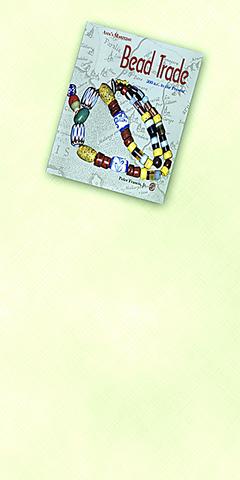When British traders landed on Madagascar in 1630 they found the people uninterested in cloth, but willing to exchange an entire cow for between 7 and 12 carnelian red beads. The East India Company had recently acquired a stock of 216,550 of them, but the trade in carnelians was already very old, the gem being rated second only to lapis lazuli in Mesopotamia 6000 years ago. The Madagascans clearly understood precisely what it was they were being offered. You only had to wait a year to have a new cow, but these red beads were something else.
Up until the 19th century beads were often the prime trading medium. At the start of his hilarious and extraordinary Congo Journey (1996), Redmond O'Hanlon consults a Congolese fortune-teller and watches her use cowrie shells to see his future. These, he remarks, originated in the Maldive Islands in the Indian Ocean, were possibly brought to Africa by Arab traders in the 13th century, then carried across the Sahara in a saddle-bag slung on a camel. They were then, in the form of a necklace, used both as a charm to ensure female fertility (and to help clairvoyants), and as currency.
Everyone has heard of the Europeans obtaining valuable commodities in Africa in exchange for handfuls of cheap, brightly-colored, industrially produced beads. The assumption has been that the recipients were child-like and didn't understand the true value of things. But beads had been traded across continents long before the Europeans arrived on the scene, and what they were entering, probably unwittingly, was a trade with a long history. O'Hanlon, who's a scholar as well as a humorist, recalls that the price of a slave in 1520 was 6,370 cowries.

Some people collect stamps, others coins, and some beads -- glass, stone or "organic" (such as shells). Peter Francis Jr has been obsessed with all of them for most of his life, at least since his interest was first aroused when teaching English in Iran. Today he heads the Center for Bead Research, runs a web site (www.thebeadsite.com), and is the author of Beads of the World, a standard book on the subject which he says he circled the globe 12 times to research.
You have only to visit the Web site to see how popular bead-collecting is, and the extent to which Francis is the high priest of the cult. There are trade beads, seed beads, Czech, Venetian and Japanese beads, and there will even be a Bead Expo in Miami in May 2003.
Of course the subject is not without its disputes. Is it true the Chinese weren't interested in glass beads? (Francis says they were, and also made them). What does "Roman" mean in ancient Oriental texts? (Francis says Greeks and Egyptians were both often called Romans because their lands were part of the Roman Empire). Did Roman merchants really live in Arikamedu in western India? (Francis says certainly, because we have their narrow-necked olive oil jars). And so on.
This new book is a detailed look at the movement of beads across Asia, from 300 BC to the present. The geographical range and the time-scale are thus equally extensive. And it was a continually active business. Ships carrying consignments of bulkier goods would also carry beads, and the trade flourished, with people buying them for personal adornment, for status, for their perceived magical powers, or as tokens with a set value, and then handing them down as heirlooms.
The book confines itself to Asia, but even so there's a huge amount of ground to cover. The author opts for the maritime trade rather than the better studied Silk Road, possibly just because it is less well researched.
These sea routes are anyway fascinating in themselves. In the days of sailing, the round-trip from Europe to China would take three years, running the gauntlet of the Malacca Straits, where winds were weak and pirates plentiful. The Arabs, however, had worked out how to squeeze the trip into 12 months, taking full advantage of the seasonal monsoons by departing on one specific day of the year.
Taiwan makes an appearance via the Chinese-made bead heirlooms of the Paiwan aborigines. The author acknowledges help from Taipei's Taiwan Museum (currently closed following earthquake damage in March), and samples of these necklaces are apparently held there.
Francis is quite astonishingly learned, and his footnotes are a marvel in themselves. It's always an honor to listen in to the talk of experts, and reading this book gives you precisely that feeling. If you want to know whether beads made in Egypt had short production runs (and so can be readily dated) or were made unchanged in design of 1,500 years, then Francis is your man.
Striped beads, mosaic beads, tubular beads, folded beads, pierced beads, stratified beads, gold-glass beads, segmented beads, translucent beads, combed polychrome beads, polished and drilled beads, leadless glass beads, opaque white beads -- the profusion is extraordinary considering that a bead is simply a nugget of material with a hole through it. "Simply?" you can hear Francis exclaim incredulously. "There's nothing simple about them! They're the most varied things imaginable!"
Nevertheless, this is probably not the book for would-be collectors. If you see someone sitting on a Taipei street offering a few strings of beads among the jade and polished Buddhas, the volume to aid identification would be the 2nd edition of Beads of the World (1999). This book, by contrast, is a scholarly survey of an entire system, of manufacture and distribution, the ebb and flow of stylistic and technical influences, covering half the world.
The final impression on finishing it is of the vastness and variety of Asia, the antiquity of its civilizations, and the interconnectedness of its traditions. This is probably not what the author aimed to convey, though he undoubtedly has a very strong feeling for it. But it is nevertheless what a non-expert gleans from this magisterial and meticulous, and to professionals undoubtedly near-definitive, overview -- that, and a sense of wonder.

June 2 to June 8 Taiwan’s woodcutters believe that if they see even one speck of red in their cooked rice, no matter how small, an accident is going to happen. Peng Chin-tian (彭錦田) swears that this has proven to be true at every stop during his decades-long career in the logging industry. Along with mining, timber harvesting was once considered the most dangerous profession in Taiwan. Not only were mishaps common during all stages of processing, it was difficult to transport the injured to get medical treatment. Many died during the arduous journey. Peng recounts some of his accidents in

“Why does Taiwan identity decline?”a group of researchers lead by University of Nevada political scientist Austin Wang (王宏恩) asked in a recent paper. After all, it is not difficult to explain the rise in Taiwanese identity after the early 1990s. But no model predicted its decline during the 2016-2018 period, they say. After testing various alternative explanations, Wang et al argue that the fall-off in Taiwanese identity during that period is related to voter hedging based on the performance of the Democratic Progressive Party (DPP). Since the DPP is perceived as the guardian of Taiwan identity, when it performs well,

A short walk beneath the dense Amazon canopy, the forest abruptly opens up. Fallen logs are rotting, the trees grow sparser and the temperature rises in places sunlight hits the ground. This is what 24 years of severe drought looks like in the world’s largest rainforest. But this patch of degraded forest, about the size of a soccer field, is a scientific experiment. Launched in 2000 by Brazilian and British scientists, Esecaflor — short for “Forest Drought Study Project” in Portuguese — set out to simulate a future in which the changing climate could deplete the Amazon of rainfall. It is

What does the Taiwan People’s Party (TPP) in the Huang Kuo-chang (黃國昌) era stand for? What sets it apart from their allies, the Chinese Nationalist Party (KMT)? With some shifts in tone and emphasis, the KMT’s stances have not changed significantly since the late 2000s and the era of former president Ma Ying-jeou (馬英九). The Democratic Progressive Party’s (DPP) current platform formed in the mid-2010s under the guidance of Tsai Ing-wen (蔡英文), and current President William Lai (賴清德) campaigned on continuity. Though their ideological stances may be a bit stale, they have the advantage of being broadly understood by the voters.